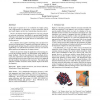Free Online Productivity Tools
i2Speak
i2Symbol
i2OCR
iTex2Img
iWeb2Print
iWeb2Shot
i2Type
iPdf2Split
iPdf2Merge
i2Bopomofo
i2Arabic
i2Style
i2Image
i2PDF
iLatex2Rtf
Sci2ools
VR
2007
IEEE
2007
IEEE
Designing and Evaluating a Haptic System for Biomolecular Education
In this paper we present an in situ evaluation of a haptic system, with a representative test population, we aim to determine what, if any, benefit haptics can have in a biomolecular education context. We have developed a haptic application for conveying concepts of molecular interactions, specifically in protein-ligand docking. Utilizing a semi-immersive environment with stereo graphics, users are able to manipulate the ligand and feel its interactions in the docking process. The evaluation used cognitive knowledge tests and interviews focused on learning gains. Compared with using time efficiency as the single quality measure this gives a better indication of a system’s applicability in an educational environment. Surveys were used to gather opinions and suggestions for improvements. Students do gain from using the application in the learning process but the learning appears to be independent of the addition of haptic feedback. However the addition of force feedback did decreas...
| Added | 04 Jun 2010 |
| Updated | 04 Jun 2010 |
| Type | Conference |
| Year | 2007 |
| Where | VR |
| Authors | Petter Bivall Persson, Matthew D. Cooper, Lena A. E. Tibell, Shaaron Ainsworth, Anders Ynnerman, Bengt-Harald Jonsson |
Comments (0)

